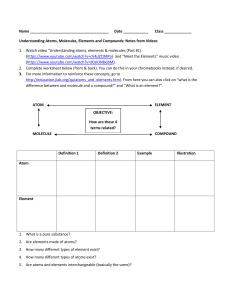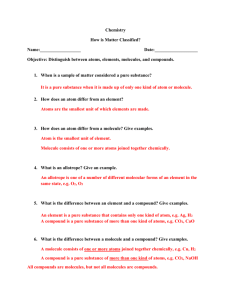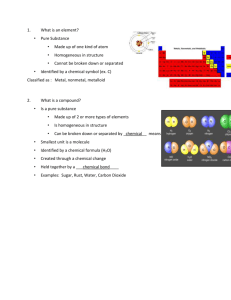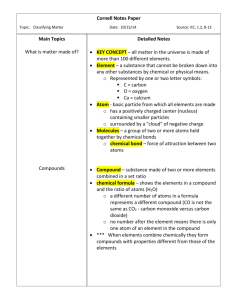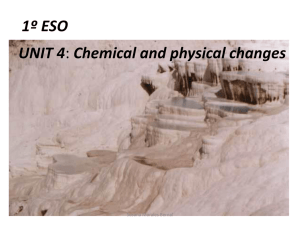5th Grade Physical Science Vocabulary
advertisement
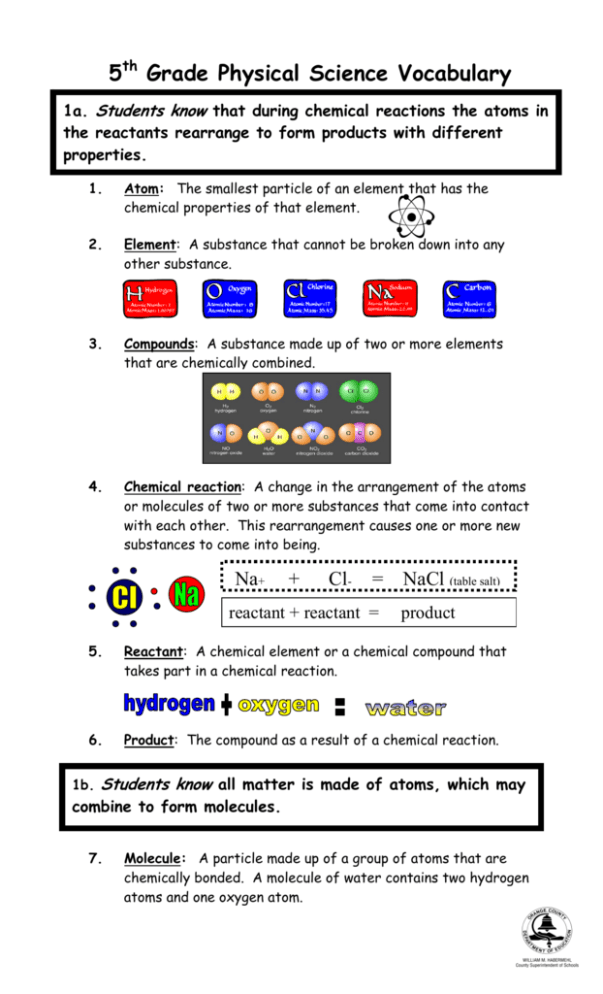
5th Grade Physical Science Vocabulary 1a. Students know that during chemical reactions the atoms in the reactants rearrange to form products with different properties. 1. Atom: The smallest particle of an element that has the chemical properties of that element. 2. Element: A substance that cannot be broken down into any other substance. 3. Compounds: A substance made up of two or more elements that are chemically combined. O 4. Chemical reaction: A change in the arrangement of the atoms or molecules of two or more substances that come into contact with each other. This rearrangement causes one or more new substances to come into being. Na+ + Cl- = reactant + reactant = NaCl (table salt) product 5. Reactant: A chemical element or a chemical compound that takes part in a chemical reaction. 6. Product: The compound as a result of a chemical reaction. 1b. Students know all matter is made of atoms, which may combine to form molecules. 7. Molecule: A particle made up of a group of atoms that are chemically bonded. A molecule of water contains two hydrogen atoms and one oxygen atom. H2O 1c. Students knows metals have properties in common, such as high electrical and thermal conductivity. Some metals, such as aluminum (Al), iron (Fe), nickel (Ni), copper (Cu), silver (Ag), and gold (Au), are pure elements; others, such as steel and brass, are composed of a combination of elemental metals. 8. 9. 10. 11. 12. 13. Metal: One of a large group of chemical elements that heat and electricity can easily move through. About 80% of the known elements are metals. Electrical conductivity: Ability to conduct electricity. Thermal conductivity: Ability to conduct or transfer heat. Alloy: A solution of two or more metals, which has properties of its own. Examples of alloys are steel and bronze. Malleable: Capable of being shaped or formed, especially by pressure or hammering. Ductile: Easily molded or shaped without breaking into pieces. 1d. Students know that each element is made of one kind of atom and that the elements are organized in the periodic table by their chemical properties. 14. Periodic table: A table that arranges all the chemical elements in rows called periods and columns called groups. 15. Chemical property: Characteristic of matter that describes how it changes when it reacts with other matter. 16. Atomic number: The number of protons in the nucleus 6 of an atom. 17. Symbol: A written sign that stands for something else. C Carbon 1e. Students know scientists have developed instruments that can create discrete images of atoms and molecules that show that the atoms and molecules often occur in well-ordered arrays. 18. Array: An arrangement of objects in rows and columns. 19. Electron microscope: A very powerful microscope that uses a beam of electrons, instead of light, to magnify objects that are too small to be seen with an ordinary microscope. 20. Scanning electron microscope: An electron microscope that makes a three-dimensional image by shooting a stream of electrons at an object and moving the stream across it. 1f. Students know differences in chemical and physical properties of substances are used to separate mixtures and identify compounds. 21. Mixtures: A combination of two or more substances that can be separated by physical means. sandwich salad 22. Compound: A substance made up of two or more elements that are chemically combined. For example, carbon dioxide is a compound that is chemically combined. 1g. Students know properties of solid, liquid, and gaseous substances, such as sugar (C6H12O6), water (H2O), helium (He), oxygen (O2), nitrogen (N2), and carbon dioxide (CO2). 23. Solid: One of three basic forms of matter. Solids are made up of molecules that can vibrate back and forth but can’t move to change places with other molecules. 24. Liquid: One of the three basic forms of matter. Liquids are made up of molecules that can move short distances. 25. Gas: One of the three basic forms of matter. The molecules of a gas are constantly moving about. 26. Solubility: The ability to be dissolved. 27. Boiling point: The temperature at which a liquid changes to a gas or vapors. 28. Freezing point: The temperature at which a liquid becomes a solid. 29. Sublimation: The process of changing from a solid to a gas, or from a gas to a solid, without turning into a liquid first. 30. Reactivity: Responsiveness to a chemical reaction. 1h. Students know living organisms and most materials are composed of just a few elements Living Organisms • Carbon • Oxygen • Hydrogen • Nitrogen • Sulfur • Phosphorus • • • • • • • • Earth’s Crust Oxygen Silicon Aluminum Iron Calcium Sodium Potassium Magnesium 1i. Students know the common properties of salts, such as sodium chloride (NaCl). 31. Salt: A compound that can be formed when an acid reacts with a base. Table salt is a compound of sodium and chlorine. 32. Nonmetal: One of a group of chemical elements that do not conduct heat or electricity well. 33. Metal: One of a large group of chemical elements that heat and electricity can easily move through. 34. Conductor: A material of an object through which heat, electricity, light, or sound can flow easily. Silver (Ag) and copper (Cu) are some of the most efficient metals and are often used in electronics. 031607192


